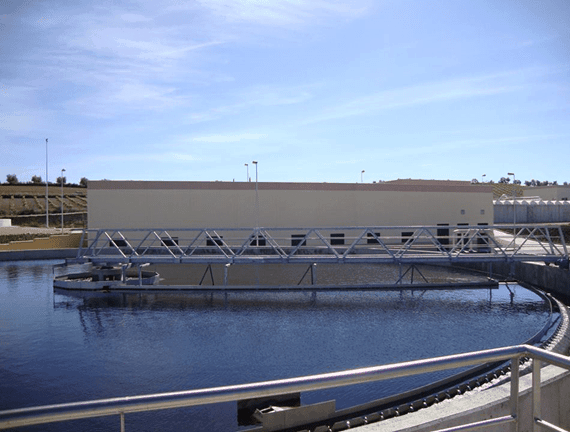
Almendralejo's new waste water treatment plant is running at full capacity
28 of July of 2014
The new waste water treatment plant in Almendralejo was built to replace the pre-existing plant, which was incapable of handling the volume of waste water produced by the town. The plant, located about six kilometres from Almendralejo, is located on the site of its predecessor. Built by the joint venture comprising Ferrovial Agroman and Cadagua, the plant is already operating at full capacity.
The waste water treatment process comprises a water line, a sludge line, a gas digestion line and ancillary facilities. With the capacity to treat 18,000 m3/day, it can serve a population of 54,545.
In the first phase, components of the new plant were built on adjacent plots while the old plant continue to operate. Once the first phase of construction was complete, the former plant was demolished, with the result that the waste water received primary treatment while the second phase of construction went ahead.
DESIGN CHARACTERISTICS
Purification is the first step in the water treatment process. First, solids larger than 3 mm and sand and fats are eliminated. The water is also pumped to a higher level so that all subsequent flow is driven by gravity.
Then the water passes through two phases of biological treatment and decantation, during which organic matter is eliminated (with a phase-A biological reactor by means of an activated sludge process, phase-A decantation through circular decanters with articulated scrapers and a moving bridge, a phase-B biological reactor, phosphorus co-precipitation in the phase-B biological reactor through the addition of ferric chloride and, finally, phase-B decantation).
Before being discharged into the river, the water is disinfected with sodium hypochlorite to eliminate pathogenic micro-organisms. The waste water treatment plant also has a buffer tank which can hold highly polluted water reaching the plant that might irremediably damage the biological process if treated conventionally.
The sludge generated in biological treatment is sent to a thickening line to separate the water out. Then it is pumped to an anaerobic digester, where it is stabilised to avoid the production of odours, and biogas with a high energy content is produced. The bulk of the water is then removed from the digested sludge using centrifuges. Finally, the dehydrated sludge is stored in two silos and, once dried, it is shipped by truck for direct use on local farmland.
This sludge line comprises the following steps:
- Screening recirculated sludge and excess sludge from phase-A.
- Pumping excess sludge from phase-A to the thickening line.
- Thickening excess sludge in phase-A by gravity.
- Pumping excess sludge from phase-B to the thickening line.
- Thickening excess sludge from phase-B by flotation.
- Mixing and homogenising thickened sludge in a mixing tank.
- Pumping thickened sludge to anaerobic digestion.
- Anaerobic digestion of sludge.
- Storing digested sludge, with mixing.
- Pumping digested sludge to dehydration.
- Dehydration of sludge via centrifugation.
- Pumping dehydrated sludge to storage.
- Storing dehydrated sludge in hoppers.
The biogas produced in the digestion process is stored in a double membrane gasometer and used in two ways: it is burned in boilers to heat the digester, or transferred to a co-generation facility, where it is burned to drive a dynamo, producing electricity to power the waste water treatment plant. Excess gas is flared. The final step of the process comprises the following elements:
- Gas compressors for stirring during anaerobic digestion.
- Overpressure fans for the gas to feed the boilers.
- Hot water boilers.
- Biogas storage at low pressure in a membrane gasometer.
- Flaring of excess gas.






There are no comments yet